From Judi Stewart the following descriptions are for trees presently available for pickup by the “North Olympic Fruit Club (NOFC) members grafted apple trees on G.41 dwarfing rootstock. This rootstock came from the Geneva, NY breeding program. It appears to be the perfect rootstock, producing high yielding apples of excellent size. Trees bear fruit early and are cold hardy. They don’t sucker and don’t have burr knots. Trees come in 3-gallon pots in a compost mix containing 20% biochar and mycorrhizae. Varieties were chosen for fresh eating, cooking, pies, juice and hard cider. We’ll help you pick the best tree for your needs. Quantities of individual trees are limited.”
Apple trees are $25 and includes membership in the fruit club. As always climatic conditions may affect the success of these old Heirloom trees. Altitude, Heat degree days, Fog, Rain amounts vary greatly in Clallam and Jefferson County but these are all worth trying simply for perpetuating trees not often found.
| Cultivar | Photo | Description |
| American Beauty | 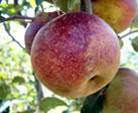 |
From Sterling, Massachusetts around the 1850’s. It is a large, dark-red apple, sweet and aromatic with slightly chewy flesh. The flavor has often been described as vinous. It is regarded as a high-quality fruit and is a very productive, annual apple.
Ripens late September to October. |
| Arabskoe | 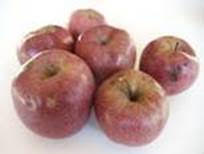 |
Mid-late fall. Probably Russian, well before 1870. Also called Arabkoe and Arabka.
Dessert and cooking apple. Good tartness with a pleasant lingering sweetness. Roundish conic barrel-shaped fruit. A stunning apple: lavender to dusky rose with a purply-pink blush, a light bloom, and russet around the stem. In 1870 the USDA imported 252 apple varieties from Russia in a frenzied attempt to locate hardy apples. The Russian names were soon mixed up beyond repair. The small but ancient apple tree was discovered on the Guptill Road in Belgrade, Maine, so for awhile it was called Guptill Lavender. |
| Crow Egg | 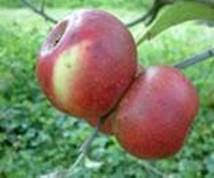 |
The old southern classic, Crow’s Egg (also known as Black Gilliflower, Raven’s Egg or Black Annie) is distinctly different in appearance and flavor from the northern Crow Egg. Southern Crow’s Egg is a dark red, very conical-shaped apple of high quality and is identical to the variety Black Gilliflower. The northern Crow Egg is a medium size apple, somewhat flattened in appearance with yellow skin flushed with red shading. The Worcester County Horticultural Society in Massachusetts has sold this variety for many years. It makes an outstanding fresh eating apple. Ripens September to early October. |
| Fallawater |  |
An old apple originating in Bucks Co., Pennsylvania before 1842 which became widely popular throughout the South. In the South the tree grows well only at altitudes above 1,500 feet. Mountain-grown fruits ripen later in the season and keep longer in cold storage. Its sweet, mild flavor and attractive large size make this a good market variety.
Fruit large to very large with dull green skin shaded with red and bronze. Flesh is greenish white, tender, coarse and juicy. Ripens late September to mid-October and is a good keeper. |
| Golden Russet | 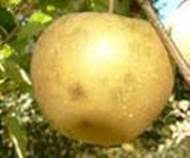 |
The American Golden Russet is a famous, old “Southern” apple which originated in Burlington County, New Jersey in the 1700’s. A widely versatile fruit, Golden Russet is excellent for fresh eating and drying but is most noted for making hard cider. Its high sugar content can produce a cider with up to 7% alcohol content. A medium sized apple, round to oblong in shape, with pale yellow skin overlaid with a rough, golden-russet coating. The yellow flesh is firm, dense, crisp and juicy. Ripens September to November. |
| Golden Sweet |  |
An extraordinarily sweet apple, so sweet that Lee Calhoun says the “first bite can be a shock.” It has no acid to balance the sweetness, so eating Golden Sweet can be like eating a tablespoon of honey. It originated in Connecticut, but details of its origin are unknown. It was once quite popular in the South and widely sold by Southern nurseries. Fruit is medium to large with thin, smooth waxy yellow skin. The sweet yellow flesh is firm, juicy, and aromatic. Ripens mid to late fall. |
| Gray Pearmain | 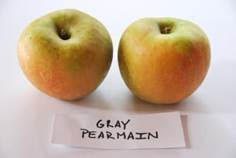 |
Probably Skowhegan, Maine, before 1870. Absolutely delicious dessert (fresh eating) apple with a distinct pear flavor and firm white juicy mildly tart flesh. Steadily gaining a devoted following. Medium-sized slightly ribbed and muffin-shaped fruit has a soft opaque greenish-yellow skin with a rosy pink blush, a russet veil, and a greyish bloom. Produces excellent juice. Pick late and eat them in the fall and all winter. Annually bearing easy-to-grow medium-sized spreading tree. Blooms midseason. Harvest fall-winter.
|
| Huntsman | 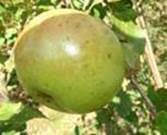 |
Originated about 1850 on the farm of John Huntsman of Fayette, Missouri, and was widely grown in Kansas and Missouri. Although prized for its fresh eating qualities and the vigor and productiveness of the tree, it was never widely sold in the South. Fruit is large, somewhat roundish with unequal sides. The smooth skin is deep yellow with an occasional reddish-orange blush and large, dark, distinct dots. The firm yellow flesh is juicy, aromatic and very flavorful. Ripens in September and is a fairly good keeper. |
| Husk Sweet | 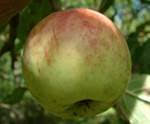 |
A wonderful fresh-eating apple which also makes outstanding pie. Reaches its pinnacle of perfection when used as a dried apple. Discovered as a wild seedling in Ashe City., N.C. in the mid 80’s. Fruit is mostly yellow with a reddish blush on the sun-exposed side. Flavor is spicy and appealing with a nice blend of sugars, a syrupy, sugary, cotton candy kind of sweetness without the slightest hint of acidity or tartness to dilute the sugary goodness. Fruit is small to medium in size and ripens in mid-October. |
| Ingram | 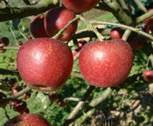 |
Ingram is a seedling of Ralls Janet which originated on the farm of Martin Ingram in Springfield, Missouri in the 1850’s. A very dependable bearer which rarely fails to produce abundant crops every year. Medium to large in size with clear, yellow skin streaked with red and crimson. Tough-skinned with firm, white, juicy flesh. Subacid in flavor. Late bloomer is protected from late spring freezes. Ripens in October. |
| Kinnaird’s Choice | 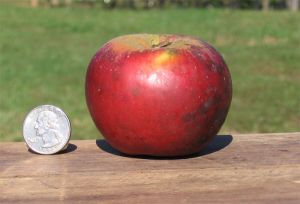 |
Originated on the farm of Michael Kinnaird in Franklin County, Tennessee. Parentage is unknown, but it may be a cross of Winesap and Limbertwig. The skin is yellow, and mottled with red, deepening to a purple-red, and covered with small, whitish dots. It is thick, tough and smooth. The white flesh is sometimes tinged yellow and is crisp, coarse-textured, aromatic and subacid in flavor. The core is small, and the seeds are short and plump. The fruit grows medium to large in size on a tree that is vigorous, upright and bushy. It bears young. Mild tart/sweet. Red. Heavy producer. Pie bakers favorite, dessert and cider making. Ripens in fall. |
| Mother |  |
Mother originated in the nineteenth century on the farm of Gen. Stephen P. Gardner of Bolton, Massachusetts. It is well adapted to the South and was very well known in central North Carolina. Medium size fruit is slightly oblong with thin, smooth, golden yellow skin mostly covered with red splashes and striping. Flesh is yellow, fine-grained, tender and juicy with a pleasant aroma. Ripens August to September in warmer areas, September to November in mountains. |
| New Brunswicker | 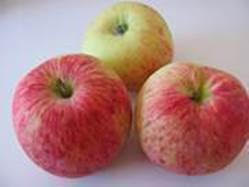 |
Aromatic with some tartness. About 1850, the great plant breeder and nurseryman Francis Peabody Sharp planted Russian apple seed obtained from a Bangor nurseryman. Years later one employee discovered a hardy, late summer apple in the nursery. It was immediately propagated and later named “New Brunswicker.” Its close resemblance to both Duchess and Alexander led many to speculate it might be a seedling of one or the other. It is so similar to Duchess of Oldenburg that several apple historians claim they are the same. In Aroostook County, New Brunswicker is considered to be a distinct variety. New Brunswicker has bright red stripes over a base of yellow. This all-purpose apple is tart when eaten fresh, but makes an excellent summer pie. It cooks into apple sauce that is soft and creamy. Triploid. Ripens late August. |
| Oliver | 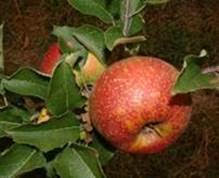 |
Early 1800’s, John Oliver of Washington County, Arkansas raised an apple tree on his farm that produced a striking red apple with large, distinctive lenticels. It became a very popular local variety and widely grown in the Ozarks of Arkansas. In 1895, Stark Bro’s Nursery sold this apple under the trademarked name, Senator. Valued for its size and high quality, it was especially noted for its long keeping abilities. Fruit size is medium to large with thick, smooth, glossy yellow skin overlaid with rich-red and streaks of darker red. The yellowish flesh is fine-grained, juicy and often stained with red. Ripens October to November. An excellent keeper. |
| Pomme Grise | 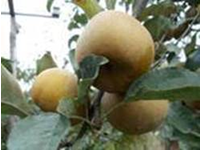 |
Unknown origin. May have originated in Europe as early as the 17th c., and probably brought to Canada’s St. Lawrence Valley by French immigrants. Found its way into Maine about 150 years ago. Medium-small russet fruit with a longtime reputation as one of the very best dessert russets. Firm, crisp, juicy, rich, subacid and aromatic, with interesting aftertastes. Very good fresh eating. The combination of the chalky russet and the green ground color give the skin its grey (grise) appearance. Recognizably different from the various Golden Russet types. Vigorous dense round spreading tree prefers northern locations. Consistently productive. Keeps fairly well,
still crunchy in January. Blooms late. |
| Redfield | 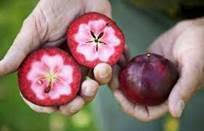 |
A highly unusual cross between Wolf River and Niedzwetzskayana Red Crab. The fruit is medium to large, waxy-pink to red. The deep-red flesh is slightly dry, making it a superb baking apple that also produces an exceptional jelly, blood red cider, or vinegar; great in pies. It is high in pectin, but is not for fresh eating, and has a short storage life. Extremely hardy tree is disease and pest free. Heavy annual bearer. Highly ornamental with bronze leaves and red blossoms. Ripens in October.
Developed at the New York Station, 1938 |
| Shockley | 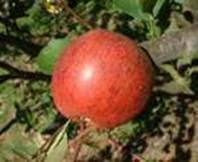 |
One of the all-time Southern favorites once grown from Virginia to Georgia. It originated with Mr. Shockley of Jackson County, Georgia in 1852 and was first exhibited at the Georgia State Fair that same year. It is an abundant and dependable bearer which grows well under all climatic and soil conditions. Fruit medium or smaller and rather oblong conical. The smooth, tough, pale yellow skin is mostly covered with bright red or crimson. The yellowish-white flesh is crisp, juicy, and sweet. Ripens October to November. |
| State Fair | 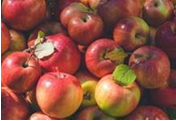 |
Introduced in 1977. Striped red, juicy, moderately tart fruit good for eating and baking. A medium-sized, bright red-striped, all-purpose apple. Semi-sweet to acid flavor, juicy with yellow flesh. Good texture, all-purpose apple. The fruit ripens in late September to early October. Will store for 2 to 4 to weeks. Prone to biennial bearing. |
| Tolman Sweet | 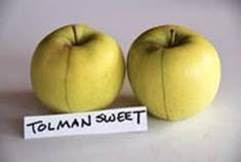 |
Antique variety. One of the first American apples and one of the few to remain popular for centuries. Truly an all-purpose fruit, used for cider, a culinary treat for drying, cooking, dessert, pickled apples, and even animal fodder. Especially prized in Maine for apple cake. Large green or yellow apple, reliable bearer, sometimes blushed red with lines of russet, often marked by a suture top to bottom. Flesh is firm, dry to moderately juicy, decidedly sweet. Historically, a highly esteemed “sweet” apple.. Unforgettably peculiar sweet strange flavor. Very low acidity. Long-lived heavy-bearing vigorous tree. Thought to originate from Massachusetts, circa 1822. Cold-hardy. Blooms midseason. Ripens in October.
|
| Vandevere | 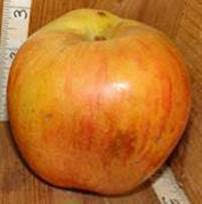 |
The origin of Vandevere Apples is not confirmed, but many sources speculate that it originated at the end of the 1700s, certainly before 1804, on a farm belonging to a family called “Vandiver” in Wilmington, Delaware, USA. Fruit is medium size or larger with yellow skin overlaid with pale red stripes. Inside, they have tender, firm (even hard), juicy yellowish flesh with a sweet taste. The flesh is so firm that one of the apple’s names became “Grindstone.” A good keeper, it becomes greasy feeling in storage and loses some crispness, but remains an excellent cooking apple until March or April. The firm, tender yellow flesh is crisp, juicy and sweet. Ripens in October or later.
|
| Western Beauty | 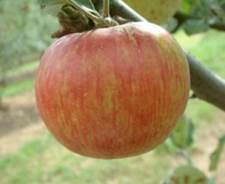 |
Believed to have originated in Marietta, Pennsylvania in 1815. Fruit closely resembles Summer Rambo, but ripens later. Considered one of the best fall apples. Fruit is large and conical in shape. The skin is thin and greenish-yellow covered with a dull red coat overlaid with deep red striping. Flesh is greenish-white, juicy, tender and mild. nearly covered with pale, dull-red, and striped with darker-red; dots large, gray and yellow; Stem short to medium length in a large, sometimes russeted cavity; calyx closed or half open; basin large, broad, slightly-corrugated. Never watercores and not disposed to rot.
|
| Windham Russet | 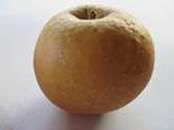 |
Excellent dessert apple for the connoisseur. The darkish brown russet skin has a distinctly bumpy rough texture, unlike any other russet. The stem area is sometimes lipped like Pewaukee. Won at the Franklin County Cider Days apple tasting in November 2013 beating out some really great apples. This apple is making a big comeback. Dessert. Late fall.
|
| Yankee Sweet | 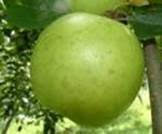 |
Once very popular in Floyd County and around Roanoke, Virginia, but quite rare and unknown today. Origin unclear. Its mild, sweet flavor makes this a pleasant fresh-eating apple but it is at its best when turned into apple preserves or marmalade. Also excellent for applesauce and apple butter. Fruit is medium-sized and slightly flattened on the ends with light green or yellow skin. The fine-grained yellowish flesh is moderately crisp, juicy and sweet. Ripens August to September. |
Author Judi Stewart
“Everybody’s twelve years old in an apple orchard.” – Rachel Ray.

Other apples and crabs of merit include:
1 Alma Sweet x x Sweet when ripe. Good for sauce
1 Akane x x sweet/tart, juicy, very aromatic, resistant to scab and mildew, also good dried
1 Aromatic Subacid, ripens in August. Medium size
1 Bakran x x Red flesh, sweet, sharp flavor, For drying, cooking, juicing and fresh eating
1 Barry McIntosh x x Juicy, sweet/tart, slightly aromatic, for eating and pies
1 Ben Hur x Sprightly subacid, late Nov ripens. Eating apple
1 Bottle Greening x x x keeps up to 4 months
1 Braeburn x x tangy, spicy sweet
2 Burgundy x good fresh eating, juicy and honey sweet.
1 Calville Blanc d’Hiver x holds shape well when baked. Good for French apple tarts
1 Cameo x x good in pies, tarts and salads. up to 5 months in storage
3 Chenango Strawberry x x fresh eating, sauce and pies. Ripens over several weeks
1 Champlain x x dessert and cooking apple. Juicy, subacid taste
1 Collins x Sprightly subacid, cooking
1 Criterion x slightly tart, slow to brown, stores well.
1 Elstar (small) x x crisp, very juicy, sweet/tart & honeyed, acid when picked, matures in storage
1 Elstar, Luster x x a redder strain of Elstar
1 Freyberg x small, golden green apple, notes of brandy and cinnamon
1 Gravenstein, Yellow x x x More yellow sport of Gravenstein
1 Grimes Golden x x 18 brix, browns slowly in air. Keeps up to 4 months. Resistant to mildew.
1 Haas x x white firm flesh, fragrant, juicy, ripens in Oct
1 Hoople’s Antique Gold x russet sport of Golden Delicious, rich, lightly aromatic, sweet
1 Idared x x x sweet-tart. applesauces and pies, great for apple strudel.
1 Liberty x x x Highly resistant to scab and mildew, somewhat resistant to blight and rust.
1 Lowell x x Sprightly subacid, yellow white flesh, eating, cooking
1 Macfree x x Resistant to scab and blight, 3 months in storage
1 Maigold x dessert apple, sweet-sharp taste, slightly honeyed.
2 Malling Kent x crunchy and juicy with a sweet/sharp aromatic flavor.
2 Mann x x tastes like Jolly Ranchers, subacid
1 Mother x x x tender, very juicy, pear drop aroma, hints of vanilla
1 Northern Spy, Early x x x ripens in winter and stores well. High Vitamin C content
2 Nova Spy x x x Resistant to scab, fresh eating or in pies
2 Pink Pearmain x Pink apples! Blend of sweet and tart, late sept
1 Pink Sparkle x x Pink apples! Tart and mildly sweet
1 Pink Wood Subacid, oxidizes quickly, small apple, sometimes flesh is pink
1 Pitmaston Pineapple x small golden apples with honey sweet and nutty taste. Great for juicing, scab resistant, self fertile
1 Pixie Crunch x small apples perfect for kid size snack. Super crunchy / super sweet
1 Rome Beauty x x Popular cooking apple, very rich when cooked
1 Rosey Glow x x one of the best early apples
1 Sansa x early season, high quality dessert apple, complex, sweet, aromatic
2 Spartan x x becomes sweeter in storage, maintains sweet flavor when baked into pies, crisps and turnovers
2 Spigold x late Sept, keeps for 3 months. Flavor is similar to Golden Delicious
2 Spur Mac x x x tart, spicy, aromatic, sprightly, heavy yields
1 Streaked Pippin x x Pleasant subacid, slightly aromatic, fresh eating, cooking
1 Sunrise z early season, crisp, sweet, tart flavor.
2 Sweet Bough x x early season, crisp, very sweet flavor.
2 Sweet Sixteen x mid season, easy to grow, resistant to scab, fireblight
1 Tolman Sweet x x x Ripens in Oct, sweet apple.
2 Tsugaru Homei x Ripens in Sept, richer flavor than the Fuji
1 Walbridge x White flesh, tender, juicy, sprightly, rather mild subacid.
1 Wheeler’s Golden Russet x x x strong flavored juice is good for hard cider making
1 Yoko x Sweet, low acid, sprightly, fresh eating
1 Zestar! x Early season sweet tart apple with a hint of brown sugar
Crabapples ($15) Great as pollinators
1 Scugog Red Crab x sweet/tart, good for juice, eating, ornamental
2 Eden Crab x x refreshingly aromatic
1 Montreal Beauty Crab x subacid, very slightly astringent, good for jelly & cider
1 Wickson Crab x x x extraordinary balance of sugar, acid, and aroma, refreshing tang